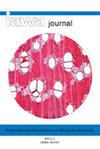Radial growth rate does not affect radial variation of latewood tracheid length in aged trees of Thujopsis dolabrata var. hondae
IF 3.5
3区 农林科学
Q2 FORESTRY
引用次数: 0
Abstract
Tracheid length is lowest at the pith and then it increases rapidly as cambial age increases up until it reaches an asymptote value in what is known as ‘Sanio’s first law’. However, it is still unclear the effect of radial growth rate on latewood tracheid length and the effect of radial variation pattern of latewood tracheid length on the boundary position between juvenile and mature wood in aged trees. Radial variation modeling was applied to annual ring width and latewood tracheid length in aged trees (79–238 years old) of Thujopsis dolabrata var. hondae grown in natural forests and a plantation in Shimokita Peninsula, Aomori, Japan. In addition, the effect of differences in radial variation patterns of latewood tracheid length on the boundary age between juvenile and mature wood was evaluated. Cambial age showing the maximum values of current annual increment and mean annual increment was 42–121 and 65–189 years for natural forests and 30–33 and 46–52 years for the plantation, respectively. A mixed-effects model based on a logarithmic function with an explanatory variable of only cambial age, and random intercepts of stand and individual tree, was selected as the one best explaining the radial variation of latewood tracheid length. The estimated boundary cambial age was approximately 20 years in all trees regardless of radial growth rate. We concluded that (1) the regularity of radial variation in tracheid known as ‘Sanio’s first law’ can be adapted to at least about 250 annual rings from the pith in T. dolabrata trees, (2) the boundary cambial age is similar to that in younger trees, and (3) the effect of radial growth rate on latewood tracheid length is minimal in T. dolabrata.径向生长率不影响红松老树晚木管胞长度的径向变化
管胞长度在髓部最低,然后随着形成层年龄的增加而迅速增加,直到达到渐近线值,这就是所谓的“赛尼奥第一定律”。然而,径向生长率对杉木管胞长度的影响以及杉木管胞长度的径向变化模式对老树幼木和成熟木边界位置的影响尚不清楚。采用径向变化模型对生长于日本青森下野半岛天然林和人工林的79 ~ 238年树龄的dolabrata var. hondae胡柏(Thujopsis dolabrata var. hondae)年轮宽度和晚木管胞长度进行了研究。此外,还评价了晚木管胞长度径向变异模式的差异对幼木和成熟木边界年龄的影响。天然林的年增量最大值为42 ~ 121年,平均年增量最大值为65 ~ 189年,人工林的年增量最大值为30 ~ 33年,人工林年增量最大值为46 ~ 52年。选择以形成层年龄为解释变量、随机截距为林分和单株的对数函数为解释变量的混合效应模型最能解释杉木管胞长度的径向变化。无论径向生长速率如何,所有树木的边界形成层年龄估计约为20年。研究结果表明:(1)圆叶桐管胞径向变化规律(Sanio’s first law)至少适用于250个左右的年轮;(2)边界形成层年龄与幼树相似;(3)径向生长率对圆叶桐后枝管胞长度的影响最小。
本文章由计算机程序翻译,如有差异,请以英文原文为准。
求助全文
约1分钟内获得全文
求助全文
来源期刊

IAWA Journal
农林科学-林学
CiteScore
3.40
自引率
15.80%
发文量
26
审稿时长
>36 weeks
期刊介绍:
The IAWA Journal is the only international periodical fully devoted to structure, function, identification and utilisation of wood and bark in trees, shrubs, lianas, palms, bamboo and herbs. Many papers are of a multidisciplinary nature, linking
 求助内容:
求助内容: 应助结果提醒方式:
应助结果提醒方式:


